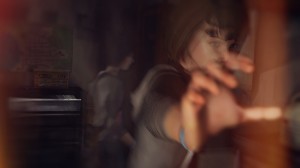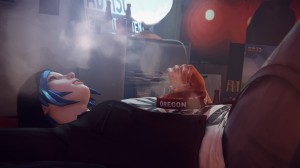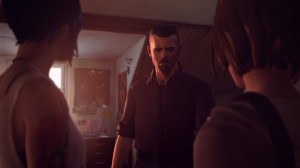Mike and Stuart wish they could rewind to the start of EGX
 Life is Strange was Square Enix’s prime unveiling at a press event held at a private venue just outside EGX in London. Originally announced in early August and debuted at Gamescom, Life is Strange is being developed by Dontnod, best known for last year’s Remember Me. It is an environmental puzzle game that will be released in episodically increments that Dontnod are hoping will be as frequent as six weeks. The game’s main protagonist, Max, is a teenage girl who has moved back to her hometown of Arcadia Bay after being away for five years. Apart from dealing with the usual issues that a teen has to face these days, Max stumbles into the midst of a mystery concerning missing teenagers and also discovers a strange new talent – she can rewind small amounts of time to change the outcome of certain events.
Life is Strange was Square Enix’s prime unveiling at a press event held at a private venue just outside EGX in London. Originally announced in early August and debuted at Gamescom, Life is Strange is being developed by Dontnod, best known for last year’s Remember Me. It is an environmental puzzle game that will be released in episodically increments that Dontnod are hoping will be as frequent as six weeks. The game’s main protagonist, Max, is a teenage girl who has moved back to her hometown of Arcadia Bay after being away for five years. Apart from dealing with the usual issues that a teen has to face these days, Max stumbles into the midst of a mystery concerning missing teenagers and also discovers a strange new talent – she can rewind small amounts of time to change the outcome of certain events.
We were only witness to a small part of one of the episodes but it was still an early part of the overall game.
Our look at the game started after a hectic day at school, where Max discovers her old friends resented her moving away and has become more bitter towards Max on her return. Her best friend from before she left, Chloe, is the other character we were introduced to and learned a bit about. Chloe’s father passed away and she harbours a lot of ill feelings towards her quick tempered military step-father. The relationship between Max and Chloe was interesting as we watched the game unfold, we were able to witness multiple outcomes of the same situation thanks to Max’s rewind power. No matter which action was chosen using the power, the relationship between the two remained constant with Chloe’s rebellious nature bouncing off Max’s over cautious one.
 Chloe and Max set off on an adventure to discover what happened to Chloe’s friend Rachel Amber. Rachel was there for Chloe when Max left and Chloe views her as her “Angel”. The school and local community believe that Rachel simply ran away, but Chloe feels that Rachel would not do that to her. The abandonment issues that Chloe seems to have reinforced her belief that her “Angel” would not do this to her. As you explore the locations of Arcadia Bay you are prompted options for the objects that you can interact with. These are shown with text, arrows and the button to press. The way these are visually shown though is as if they are notes in a teenage girl’s diary.
Chloe and Max set off on an adventure to discover what happened to Chloe’s friend Rachel Amber. Rachel was there for Chloe when Max left and Chloe views her as her “Angel”. The school and local community believe that Rachel simply ran away, but Chloe feels that Rachel would not do that to her. The abandonment issues that Chloe seems to have reinforced her belief that her “Angel” would not do this to her. As you explore the locations of Arcadia Bay you are prompted options for the objects that you can interact with. These are shown with text, arrows and the button to press. The way these are visually shown though is as if they are notes in a teenage girl’s diary.
The narration throughout the game by Max does not only serve as a story telling technique but as a hint system as well. The best example of this is when you are searching for tools to fix your camera. Max spots a set of screwdrivers balanced precariously on the edge of a washing machine. The obvious thing to do is to operate the machine to get them to drop off the edge and collect them. However, when you do this they drop to the floor and underneath a cupboard that you can’t reach. Max then says “I should have put the cardboard down”, hinting that you need to rewind this section and place a piece of cardboard under the cupboard before turning the machine on. These examples of player support through the feedback of the protagonist whilst not breaking the 4th wall were really nice – it’s just a teenager talking to themself.
 The main gameplay mechanic we were shown in the demo was the rewind power. The power allows Max to stay in her current place and rewind the world around her. As this rewind takes place Max is able to watch everyone around her moving in reverse, and where she would have been during the rewind, there is a shadowy figure in her place. The rewind power can be used as many times as you wish allowing you to investigate all the possible outcomes in a section. The game did have regular checkpoints which were signified by a butterfly graphic in the top left of the screen. Once past a checkpoint, Max is not able to rewind events before this and must stick with those choices. We were also told that there were multiple endings to the game depending on the choices we made.
The main gameplay mechanic we were shown in the demo was the rewind power. The power allows Max to stay in her current place and rewind the world around her. As this rewind takes place Max is able to watch everyone around her moving in reverse, and where she would have been during the rewind, there is a shadowy figure in her place. The rewind power can be used as many times as you wish allowing you to investigate all the possible outcomes in a section. The game did have regular checkpoints which were signified by a butterfly graphic in the top left of the screen. Once past a checkpoint, Max is not able to rewind events before this and must stick with those choices. We were also told that there were multiple endings to the game depending on the choices we made.
The look of the Life is Strange is fantastic, with each texture being hand painted. The attention to detail in the graphics and the sound of the game attains the desired aesthetic of the American North West with relative ease and was an absolute pleasure to see. Life is Strange is marketed as a treble A indie title. The size of the development team is huge compared to an Indie title (in this case more than 40) and minuscule in comparison to the size of the development teams for AAA games. Dontnod are hoping that this and their love of adventure games will put Life is Strange in the same category as TellTale’s awesome ‘The Walking Dead’ games.
 Life is strange is a fascinating title from Dontnod. It’s an example of how games can be both art but also enjoyable. The enjoyment doesn’t come from blaring music or fancy OTT graphics, but from all the intrigue that arises from the story and the nice little touches the developers have added to make this game feel that you are playing out a real story. We cannot wait to get a hands on trial of the game and hope it continues on the current path it is on.
Life is strange is a fascinating title from Dontnod. It’s an example of how games can be both art but also enjoyable. The enjoyment doesn’t come from blaring music or fancy OTT graphics, but from all the intrigue that arises from the story and the nice little touches the developers have added to make this game feel that you are playing out a real story. We cannot wait to get a hands on trial of the game and hope it continues on the current path it is on.
